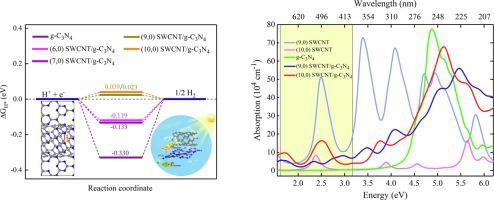当前位置:
X-MOL 学术
›
Appl. Surf. Sci.
›
论文详情
Our official English website, www.x-mol.net, welcomes your
feedback! (Note: you will need to create a separate account there.)
Insight into enhanced visible-light photocatalytic activity of SWCNTs/g-C3N4 nanocomposites from first principles
Applied Surface Science ( IF 6.3 ) Pub Date : 2020-11-01 , DOI: 10.1016/j.apsusc.2020.147181 Liang Xu , Jian Zeng , Quan Li , Tong Chen , Kai-Wu Luo , Xin Luo , Bojun Peng , Zongle Ma , Ling-Ling Wang , Xiaojun Zhu , Shuhui Huang , Desheng Liu , S.X. Xiong , Cijun Shuai
Applied Surface Science ( IF 6.3 ) Pub Date : 2020-11-01 , DOI: 10.1016/j.apsusc.2020.147181 Liang Xu , Jian Zeng , Quan Li , Tong Chen , Kai-Wu Luo , Xin Luo , Bojun Peng , Zongle Ma , Ling-Ling Wang , Xiaojun Zhu , Shuhui Huang , Desheng Liu , S.X. Xiong , Cijun Shuai

|
Abstract Single-walled carbon nanotubes (SWCNTs) modified g-C3N4 nanocomposites have attracted extensive attention due to their good photocatalytic activity for water splitting in the visible region, but the theoretical research on the enhancement mechanism is still lacking. Using first-principles hybrid density functional calculations, the potential photocatalytic enhancement mechanism of SWCNTs-modified g-C3N4 has been studied in detail. For different metal (9,0) and semiconductor (10,0) SWCNTs modified patterns, the two components are always linked by van der Waals forces without exception. Obvious structural folds in g-C3N4, large interlayer charge transfer, significantly enhanced visible light absorption, and smaller |ΔGH*|, these factors enhance the photocatalytic activity of SWCNTs/g-C3N4. Interestingly, (10,0) SWCNT have better coordination advantage with g-C3N4 than (9,0) SWCNT, resulting in (10,0) SWCNT/g-C3N4 nanocomposite with more visible structural folding for more stable structures, greater charge transfer, and more efficient visible light absorption spectra. Moreover, we also studied the photocatalytic performance of g-C3N4 modified by metal (6,0) and semiconductor (7,0) SWCNTs. As a result, the photocatalytic performance of the latter is significantly better than the former, which further shows that the semiconductor SWCNTs-modified g-C3N4 maybe more superior. The findings pave the way for the development of highly active g-C3N4-based photocatalysts.
中文翻译:

从第一性原理洞察 SWCNTs/g-C3N4 纳米复合材料增强的可见光光催化活性
摘要 单壁碳纳米管(SWCNTs)修饰的g-C3N4纳米复合材料由于在可见光区具有良好的光催化分解水的活性而受到广泛关注,但对其增强机理的理论研究尚缺乏。使用第一性原理混合密度泛函计算,详细研究了单壁碳纳米管修饰的 g-C3N4 的潜在光催化增强机制。对于不同的金属 (9,0) 和半导体 (10,0) 单壁碳纳米管修改图案,这两个组件总是无一例外地通过范德华力连接。g-C3N4 中明显的结构折叠、大的层间电荷转移、显着增强的可见光吸收和更小的|ΔGH*|,这些因素增强了 SWCNTs/g-C3N4 的光催化活性。有趣的是, (10, 0) SWCNT 与 g-C3N4 比 (9,0) SWCNT 具有更好的配位优势,导致 (10,0) SWCNT/g-C3N4 纳米复合材料具有更可见的结构折叠以获得更稳定的结构、更大的电荷转移和更有效的可见光光吸收光谱。此外,我们还研究了由金属 (6,0) 和半导体 (7,0) SWCNT 改性的 g-C3N4 的光催化性能。结果,后者的光催化性能明显优于前者,这进一步表明半导体SWCNTs修饰的g-C3N4可能更优越。这些发现为开发高活性 g-C3N4 基光催化剂铺平了道路。和更有效的可见光吸收光谱。此外,我们还研究了由金属 (6,0) 和半导体 (7,0) SWCNT 改性的 g-C3N4 的光催化性能。结果,后者的光催化性能明显优于前者,这进一步表明半导体SWCNTs修饰的g-C3N4可能更优越。这些发现为开发高活性 g-C3N4 基光催化剂铺平了道路。和更有效的可见光吸收光谱。此外,我们还研究了由金属 (6,0) 和半导体 (7,0) SWCNT 改性的 g-C3N4 的光催化性能。结果,后者的光催化性能明显优于前者,这进一步表明半导体SWCNTs修饰的g-C3N4可能更优越。这些发现为开发高活性 g-C3N4 基光催化剂铺平了道路。
更新日期:2020-11-01
中文翻译:

从第一性原理洞察 SWCNTs/g-C3N4 纳米复合材料增强的可见光光催化活性
摘要 单壁碳纳米管(SWCNTs)修饰的g-C3N4纳米复合材料由于在可见光区具有良好的光催化分解水的活性而受到广泛关注,但对其增强机理的理论研究尚缺乏。使用第一性原理混合密度泛函计算,详细研究了单壁碳纳米管修饰的 g-C3N4 的潜在光催化增强机制。对于不同的金属 (9,0) 和半导体 (10,0) 单壁碳纳米管修改图案,这两个组件总是无一例外地通过范德华力连接。g-C3N4 中明显的结构折叠、大的层间电荷转移、显着增强的可见光吸收和更小的|ΔGH*|,这些因素增强了 SWCNTs/g-C3N4 的光催化活性。有趣的是, (10, 0) SWCNT 与 g-C3N4 比 (9,0) SWCNT 具有更好的配位优势,导致 (10,0) SWCNT/g-C3N4 纳米复合材料具有更可见的结构折叠以获得更稳定的结构、更大的电荷转移和更有效的可见光光吸收光谱。此外,我们还研究了由金属 (6,0) 和半导体 (7,0) SWCNT 改性的 g-C3N4 的光催化性能。结果,后者的光催化性能明显优于前者,这进一步表明半导体SWCNTs修饰的g-C3N4可能更优越。这些发现为开发高活性 g-C3N4 基光催化剂铺平了道路。和更有效的可见光吸收光谱。此外,我们还研究了由金属 (6,0) 和半导体 (7,0) SWCNT 改性的 g-C3N4 的光催化性能。结果,后者的光催化性能明显优于前者,这进一步表明半导体SWCNTs修饰的g-C3N4可能更优越。这些发现为开发高活性 g-C3N4 基光催化剂铺平了道路。和更有效的可见光吸收光谱。此外,我们还研究了由金属 (6,0) 和半导体 (7,0) SWCNT 改性的 g-C3N4 的光催化性能。结果,后者的光催化性能明显优于前者,这进一步表明半导体SWCNTs修饰的g-C3N4可能更优越。这些发现为开发高活性 g-C3N4 基光催化剂铺平了道路。











































 京公网安备 11010802027423号
京公网安备 11010802027423号